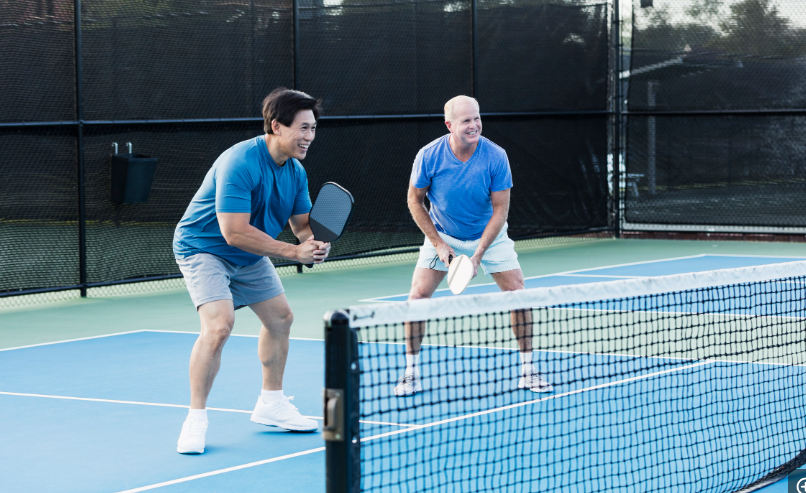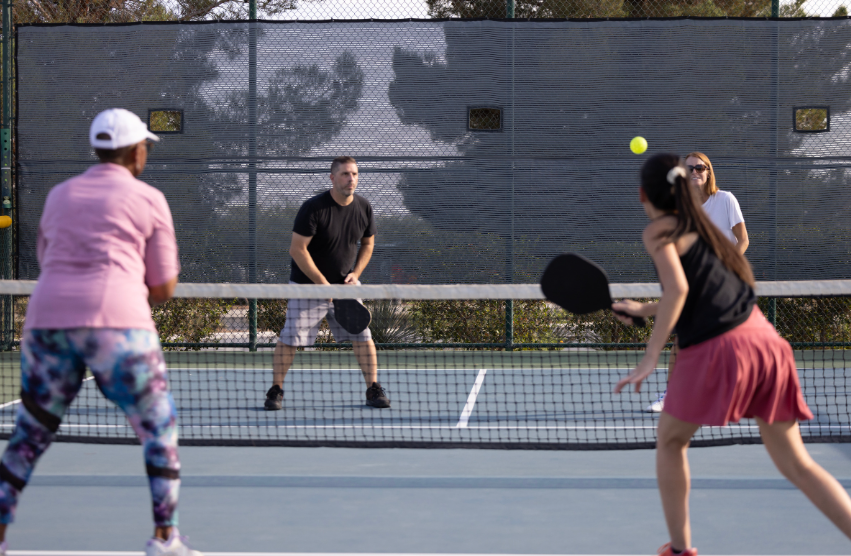Pickleball doubles requires strong communication and coordination between partners to achieve success on the court. Effective teamwork and synchronized movements can create a formidable force that outplays the opposition. In this article, we will delve into essential doubles tactics that emphasize communication and coordination. By developing a common game plan, establishing clear communication, understanding court positioning, and coordinating your movements, you and your partner can maximize your strengths, cover the court efficiently, and increase your chances of victory in pickleball doubles.
- Establishing a Game Plan (150 words): Before stepping onto the court, it’s crucial for doubles partners to establish a game plan. Discuss and agree upon the overall strategy for the match. Determine each player’s strengths and preferred positions on the court. Decide whether to play aggressively at the net or focus on a more defensive approach. A well-defined game plan provides a framework for effective communication and coordination during the game.
- Clear and Continuous Communication (150 words): Constant communication is key in pickleball doubles. Establish clear signals or verbal cues to indicate who will take specific shots or cover certain areas of the court. Use simple and concise language to convey important information quickly. Communicate before, during, and after each point to keep each other informed and to make adjustments as needed. Effective communication ensures that both players are on the same page and can anticipate each other’s movements.
- Understanding Court Positioning (150 words): Court positioning is a critical aspect of pickleball doubles. Coordinate with your partner to divide the court efficiently. Maintain a strong presence at the net to control the game and put pressure on your opponents. The player at the net should be ready to intercept shots and put away volleys. The player at the baseline should provide deep and accurate groundstrokes while maintaining good court coverage. Understanding and executing proper court positioning allows you to defend effectively and attack strategically.
- Coordinating Movement (150 words): Smooth movement and seamless coordination are vital for successful pickleball doubles. Anticipate your partner’s movements and be ready to adjust accordingly. Move together as a unit, maintaining an optimal distance from each other to cover a larger portion of the court. Utilize quick and efficient footwork to respond to different shots. Practice drills that focus on synchronized movements, such as cross-court dinking or poaching, to improve coordination. By moving as a cohesive unit, you can effectively counter your opponents’ strategies and exploit openings on the court.
- Capitalizing on Partner’s Shots (150 words): Being aware of your partner’s shots is crucial for successful doubles play. Look for opportunities to capitalize on the shots your partner sets up. If your partner hits a strong shot, move forward to the net and be ready to put away the next shot with a volley or overhead smash. If your partner hits a soft shot, provide cover by moving back and being prepared to defend any potential aggressive shots from your opponents. By capitalizing on your partner’s shots, you can maintain control and keep the pressure on your opponents.
- Mastering the “Stacking” Technique (150 words): The “stacking” technique is a popular strategy in pickleball doubles that involves positioning yourselves in a specific formation to gain an advantage. Instead of staying on the same side of the court, one player moves to the opposite side, creating a diagonal formation. This allows both players to have their forehands in the middle of the court, increasing their shot options and minimizing vulnerability to cross-court shots. Mastering the stacking technique requires coordination and communication with your partner. Practice transitioning smoothly into the stacked position and be aware of each other’s movements. By utilizing this strategy effectively, you can create confusion for your opponents and maintain a strong offensive and defensive position.
- Managing the No-Man’s Land (150 words): The “no-man’s land” refers to the area between the non-volley zone and the baseline. Many players find themselves uncertain about how to handle this zone effectively. In doubles, it’s important to utilize the no-man’s land strategically. Instead of staying back at the baseline, try moving forward into the no-man’s land to cut off angles and take control of the game. This positioning allows you to be closer to the net for volleys while still being able to defend against deep shots. Communication and coordination with your partner are crucial in managing the no-man’s land effectively. Practice transitioning smoothly between the baseline and the no-man’s land and develop a sense of when to move forward and when to retreat.
- Exploiting Weaknesses and Targeting Weak Links (150 words): To outsmart your opponents in doubles, identify weaknesses and target the weak link on the opposing team. Observe the players carefully and analyze their strengths and vulnerabilities. If one player struggles with backhand shots, aim your shots towards their backhand side to exploit their weakness. Additionally, target shots at players who struggle with overhead smashes or quick reflexes. By strategically targeting weak links, you can force errors and disrupt your opponents’ rhythm. This tactic requires effective communication and coordination with your partner. Communicate your observations and adjust your game plan accordingly. By working together to exploit weaknesses, you can gain a significant advantage and dominate the match.
- Utilizing the “Pickleball Poach” (150 words): The “pickleball poach” is a tactic that involves moving across the court to intercept and hit a shot that was intended for your partner. This unexpected maneuver can catch your opponents off guard and create confusion. To execute a successful pickleball poach, timing and communication are key. Signal your intention to poach to your partner and be ready to move quickly. Anticipate your opponents’ shots and make a decisive move to intercept the ball. The poaching player can then hit an aggressive shot that disrupts the opponents’ rhythm. However, effective communication is crucial to avoid collisions or missed shots. Practice this tactic with your partner to develop a seamless understanding and coordination.
- Adjusting Strategies for Different Opponents (150 words): To outsmart your opponents in doubles, it’s essential to be adaptable and adjust your strategies based on the specific opponents you are facing. Different opponents have different playing styles, strengths, and weaknesses. Observe and analyze their game early on to identify patterns and vulnerabilities. Adjust your shot selection, court positioning, and overall game plan accordingly. If your opponents are aggressive at the net, focus on deep lobs to force them back. If they struggle with quick reactions, incorporate more fast-paced exchanges to exploit their weaknesses. By tailoring your strategies to match your opponents’ style, you can disrupt their game and gain a competitive edge.
Pickleball doubles requires effective communication, coordination, and strategic thinking. By mastering techniques such as stacking, managing the no-man’s land,






